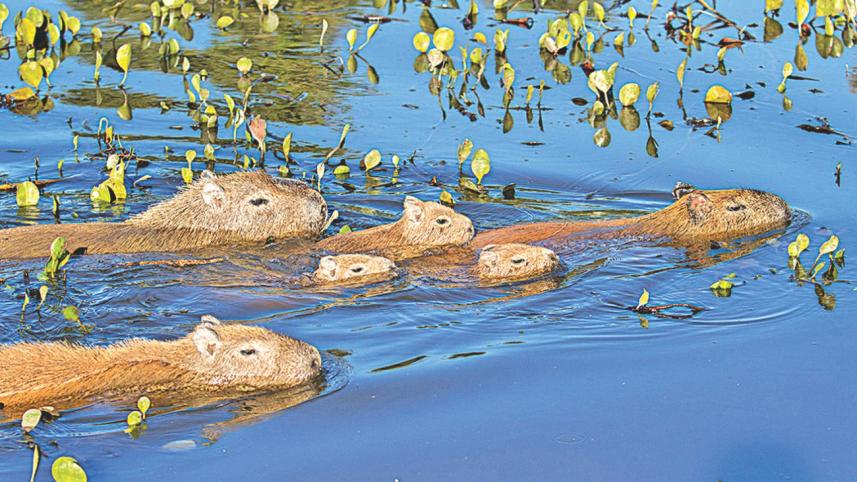The Pantanal

Imagine a Haor bigger than Bangladesh. It fills with water during the rains and empties in dry season. This is the Pantanal, one of the world's great wilderness areas. It is a wetland in Brazil's Mato Grosso state that extends into Bolivia and Paraguay. Covering between 54,000 and 75,000 square miles, it is a UNESCO World Heritage Site recognized for its ecological diversity.
The Pantanal boasts 390 bird species alongside an array of mammals, reptiles and fish. Pantanal's trees, while not monumental in the scale of the Amazon rainforest, make up in beauty and variety. They adopt various techniques – including hosting waterproof termite nests - to survive submersion half the year.
After a late-night landing at Cuiaba, gateway city to the Pantanal, our safari tour leaves the following morning headed for Pouso Alegre. The road is a flat, well-maintained highway with a view of distant mountains, some in Bolivia 250 kilometers away. The soil is red. The roadside trees are mostly unfamiliar but there is mango, guava and stretches of planted teak. Blooming mango trees disappoint me as I was hoping to sample the fruit here. Fenced off cattle ranches remind me that Mato Grosso has twenty-seven million heads of cattle and three million people. Humans are sparse: Brazil's 208 million people live in an area larger than the continental United States.
After passing the small town of Pocone we enter the famed Transpantaneira Highway – dotted by iconic wooden bridges - that crosses the wetland.
The first part of my tour is based out of a family ranch (or fazenda) which occupies 7000 acres. The affable fifth generation owner of Piuval Lodge is Louis Vicente, whose family traces its roots back to Portugal and England. He has worked to create a rich wildlife experience for visitors. Indeed, in three days, I see Capybara, Giant Ant-eaters, numerous Crocodiles (called Caimans here), Crab-eating Foxes, Capuchin and Howler Monkeys, a curious arboreal Porcupine, a giant Tapir weighing three hundred kilograms, Racoons, Barking Deer, Marmosets, as well as the glittering eyes of a jungle cat at night that was either a Jaguar or a Puma. Horses are also raised in the ranch.
While the animal encounters are impressive, it is the birds, including the exquisite but endangered Hyacinth Macaw and the playful Toco Toucan, which take my breath away.
From Pouso Alegre we travel to a different Pantanal location, the Taiama reserve, to look for Jaguars. We stop during our four hour drive whenever we see extraordinary birds such as the Red and Green Macaw. After a longish stretch on unpaved road, we reach Hotel Baiazinha on the bank of the Paraguay river. Henceforth all explorations are by boat. Both morning and afternoon, our speedboat cruises the river and its tributaries searching for wildlife. We spot five Jaguars in the first two days. On the third day a cold front moves in and frustrates out Jaguar search.
On the river we spot several groups of Giant Otters. Raised sandbars in the river host hundreds of Terns, Skimmers, Plovers and other birds which breed, raise chicks, fish, and play overhead. The Kingfishers, however, are not nearly as colourful as the ones in Sundarban.
Our hotel appears to be the only establishment for many kilometres on either bank. Besides a few tourists, some fishermen ply the river. One of them reels in a massive catfish, almost the size of a man, and releases it.
The Pantanal may be Brazil's best kept secret but its memories linger long after my visit
Follow “ihtishamkabir” on Instagram or visit facebook.com/ikabirphotographs.



 For all latest news, follow The Daily Star's Google News channel.
For all latest news, follow The Daily Star's Google News channel.
Comments